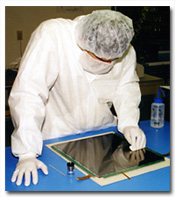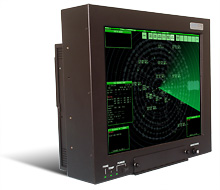Optical Bonding of Flat Panel Displays
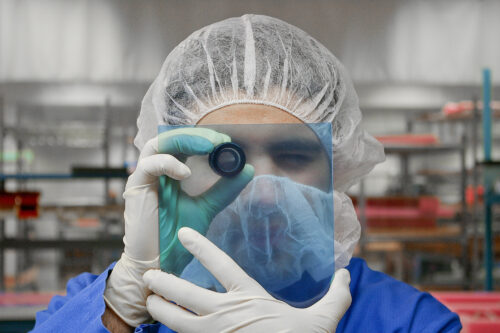 Optically bonding an LCD, OLED or Plasma display improves both optical performance and durability. By selecting an appropriate adhesive that matches the index of refraction of the flat panel and the overlay, General Digital is able to remove all of the air gaps, thus reducing the number of internal reflecting surfaces that can lead to degradation of optical performance. Providing a durable adhesion between the flat panel and the overlay improves the displays’ ability to resist shock, vibration and moisture.
Optically bonding an LCD, OLED or Plasma display improves both optical performance and durability. By selecting an appropriate adhesive that matches the index of refraction of the flat panel and the overlay, General Digital is able to remove all of the air gaps, thus reducing the number of internal reflecting surfaces that can lead to degradation of optical performance. Providing a durable adhesion between the flat panel and the overlay improves the displays’ ability to resist shock, vibration and moisture.
Optical Bonding is the affixing of two optical elements to one another using a liquid adhesive. The qualifier optical implies that the adhesive is transparent, has a suitable refractive index and is made under adequate control such that there are no significant variations in the optical properties within a single bond. In this way, we differentiate bonding from lamination.
On the practical side, the adhesive must also provide adequate bond strength, have a reasonable pot life after preparing, not present any health or safety issues, be available at reasonable cost from reliable sources, and cure to the proper finished bond condition using temperatures and times that are friendly to optical bonding facilities. Fortunately, there exist a relatively large number of choices. Typical bonded overlays include contrast enhancement filters, EMI/RFI filters, vandal shields, touch screens, and thermal heaters.
Practical Use
- Augmentation of Optical Performance of Flat Panel Display and Overlay
- Increased Luminance
- Increased Contrast
- Reduced Internal Reflections
- Improved Ruggedization
- Bonded display assemblies are able to withstand the high shock and vibration typically associated with MIL-DTL-901 and MIL-STD-810 applications
- Bonded display assemblies mimic shatterproof glass. Although the bonded overlay can fracture from impact, the adhesive prevents/minimizes broken pieces from becoming airborne and endangering the operator and other nearby personnel.
- Vandal Prevention
- Extended Operating Temperature Range Through the Use of Optically Bonded LCD, OLED or Plasma Display Heaters
- Elimination of Condensation and Moisture Between LCD, OLED or Plasma Display and Overlay
Types of Adhesives
Silicone-RTV
This adhesive has been used for more than 30 years in making bonds to displays, in both commercial and military applications. Because it is a relatively soft material, it is very feasible to rework, with minimal risk, any bonds that have a problem. The major drawback to this material is a tendency to form debris if the edge of the bond is rubbed during handling. To reduce the severity of this, we seal the edges of the bond using thin black tape or a configuration that does not expose the edge to abrasion.
Epoxy
Another adhesive that we have used successfully is a flexible epoxy formulation. This makes a much more rigid bond than silicone, but does not have the tendency to form particulate debris. It is not reworkable in the event any problems arise during production or use. However, for some designs in which the use of tape to seal the edge is not practical, this may be the adhesive of choice.
Polyurethane
Polyurethane adhesives possess good environmental integrity for use in high altitudes and may be superior at low temperatures. However, they exhibit a severe yellowing over time when exposed to high ambient (solar) lighting conditions. Because of this tendency to yellow, General Digital Optical Bonding Laboratories discourages the use of polyurethane adhesives
Integration Options
There are numerous configurations available, including over-the-frame, in-the-frame and under-the-frame, as well as behind-the-display and frameless designs. Each have their own unique attributes.
- Over-the-frame and in-the-frame bond designs require that the flat panel display first be sealed to the OEM metal frame to eliminate the possibility that the adhesive might leak into the backlight and contaminate the films. A non-corrosive silicone formulation is used to effect this seal.
- Under-the-frame, behind-the-display and frameless bonds require that the flat panel display be disassembled before the bond can be made. After the bond is cured, either the OEM frame or a custom-designed frame must be affixed to the display.
Our first experience in optical bonding was with under-the-frame bonds for the GenStar™ monitor, a 20.1″ LCD used in an FAA control tower application. This large size created some severe concerns about handling and yield. Our experiences with this were, however, very good. During 2002, General Digital Optical Bonding Laboratories bonded approximately 500 of these displays with a yield in excess of 95%. It was our early success with this product that encouraged us to offer the bonding service to other customers.
The in-the-frame design is currently in limited production, primarily for avionic applications. The adhesive is epoxy, which was selected so that the bezel could be affixed to the display’s metal frame, with the bonded antireflective glass extending into the opening, reducing any issues of viewing angle and parallax to the display.
One drawback to the under-the-frame and in-the-frame bonds is that they are not suitable for making a liquid-proof seal to the bezel of the monitor. To accomplish this, monitor builders usually prefer to form a seal to the antireflective glass. In this case, an over-the-frame bond is necessary. This bond design is also required in the case of an optically bonded touch sensor. The details of the bond may vary slightly, depending on the nature of the overlay. However, in general, an appropriate gasket is placed onto the face of the OEM frame, forming a well-defined bond thickness and protecting the edge of the seal from abrasion.
It is, of course, possible to bond more than one overlay to the display. A specific example is the use of a conductive glass to control EMI, which is bonded to a touch sensor. As of this writing, General Digital Optical Bonding Laboratories has produced over 475 displays of this design for an aerospace application.
Types of Bonds
Gasketed Optical Bond
- This bond design is the preferred over-the-frame bond. A gasket is applied between the LCD, OLED or Plasma display and the overlay and the space between them is then filled with adhesive.
- Good thermal and mechanical performance on a wide variety of sizes and overlays.
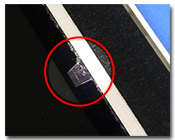 Shimmed Optical Bond
Shimmed Optical Bond
- This bond design controls the thickness of the bond through the use of shims during curing.
- Suitable for under-the-frame bonds. Can be used with over-the-frame, but a gasketed bond is preferred.
Static Optical Bond
- Bond thickness is determined by the interaction of adhesive properties, overlay weight, time and temperature.
- Only suitable for under-the-frame bonds.
- Provides the thinnest bond line.
- Rework of defective or damaged assemblies may be difficult or impossible.
Optical Bond Complexity
- Single Optical Bond Layer
- Multiple Optical Bond Layers
- Triple bond is the most complex bond to date
Target Combinations
- Glass (overlay) to Flat Panel
- Glass to Glass (robust anti-vandal shield, similar to automotive safety glass)
- Polycarbonate to Glass (flat panel) [under development]
Overlay Types
- Contrast Enhancement Filters
- Glass (32%, 62%, 75%, 92% [Clear], Triple Notch)
- Polycarbonates
Anti-Vandal Shields
Rugged filters are available in various thicknesses and diagonal sizes to protect the display from harm. Highly resistant to impact, scratching, and chemicals, they are available in several surface finishes to provide optimum viewing of a flat panel display based on a particular application. All finishes are designed for antiglare, maximum light transmission properties, and durability.
- Substrates used can be polycarbonate, acrylic, chemically strengthened glass, or thick (6 mm or more) glass.
- In many cases, bonding standard glass to the LCD, OLED or Plasma display is sufficient to withstand significant abuse in the field without failure.
EMI/RFI Shields
EMI/RFI shielding is necessary to protect against spurious RF signals or co-existing electronic or electrical systems, as well as providing high electrical isolation properties. Various applications, such as the military and medical equipment markets, can benefit the use of EMI/RFI shielding.
- Enable Display Assemblies to Satisfy FCC and MIL-STD-461 Requirements
- Optically Clear ITO Coatings Down to 5 Ohms/Square
- Configurations
- Coating must be done to one or both sides of the glass.
- A busbar is provided all around to ensure good ground contact in the final enclosure.
- The busbar can be eliminated in some designs where the EMI glass is bonded to a frame at General Digital using a conductive adhesive.
- Busbar configuration will depend on over-all system design constraints:
- U-shaped used to bring conductivity from the bonded side of the glass to the top.
- L-shaped used to bring conductivity from the ITO surface to the edge for contact with an EMI gasket mounted along the side of the display.
- Surface busbar used when the ITO surface is on the outside of the display assembly and the EMI gasket will be between the assembly and the monitor bezel.
Heaters
 Heaters help to extend the operating temperatures of flat panel displays and backlights, which will improve the LCD, OLED or Plasma display performance, especially at low operating temperatures. Typical applications include avionic displays, ruggedized electronic devices, handheld terminals, and outdoor card readers.
Heaters help to extend the operating temperatures of flat panel displays and backlights, which will improve the LCD, OLED or Plasma display performance, especially at low operating temperatures. Typical applications include avionic displays, ruggedized electronic devices, handheld terminals, and outdoor card readers.
- Optically Clear (ITO)
- Can be Combined with Other Coatings and Filters
- Extends the Expected Life of Backlights When Operated at Cold Temperatures
Touch Sensors
Touch sensor technology simplifies and improves the human interface to the display system. Rather than using keyboards, switches or buttons, designs now include touch technology to increase design flexibility while delivering a better overall user experience.
- Types of Touch Technology Available
- Resistive
- Capacitive
- Infrared (IR)
- Wave (SAW)
- Multi-Touch
- Support for virtually any touch technology or manufacturer
Specialty Optical Bonding Processes
GenGard F801™
- Specialized process enabling LCD assemblies to endure hostile and demanding environments, without compromising any discipline
- High Altitude Pressures
- Operational display systems installed in commercial and military aircraft
- Products that require transcontinental or international transportation in cargo bays at high altitudes
- Extended Temperatures*
- -45°C (limited exposure to -55°C) to +200°C†
- Heavy Shock and Vibration
- Designed to meet most military requirements‡
- Force
- Select solution tested withstood 9600 clamping cycles on the bonded screen with a clamping force of 1000 N
distributed over an area approximately 120 mm x 100 mm within the screen bezel
- Select solution tested withstood 9600 clamping cycles on the bonded screen with a clamping force of 1000 N
- Condensation and Moisture Prevention
- Removes air gap between all bonded surfaces to eliminate any potential for condensation
- High Altitude Pressures
*Extremes are limited by component selection (e.g., LCD and overlay)
†Optical bond only; selection of display, overlay and other electronics will affect temperature extremes of the complete assembly
‡Compliance is influenced by many design and integration factors, which is best discussed with an Applications Engineer to ensure that the customer’s requirements are met
Download the GenGard Data Sheet
XO-Fraim™
- General Digital-Patented Bonding Integration Technique
- Facilitates integration of bonded display subassembly into sealed enclosures
- Minimizes potential for compression bi-refringence or bond de-lamination
- Reduces risk of damage during shipping and receiving
- Customizable
Cold Temperature Optical Bond
Today’s display users are finding it more common for their units to operate in extreme temperatures. A growing trend is for the display assembly to survive in extreme cold per MIL-STD-810F. Low temperatures can have adverse effects on display systems, which can temporarily or permanently impair the visibility and operation of the display. It is imperative that this requirement be taken into consideration during the design phase. Examples of problems that may result when exposed to these extreme temperatures may include:
- Change in impact strength and reduced strength
- Condensation and freezing of water
- Static fatigue of restrained glass
- Anomalies in the optical bond including delamination, crystallization of bond material, bubbles, etc., which may or may not return to normal after temperature stabilization.
General Digital’s Optical Bonding Laboratories has thermal tested displays to -55° C. Bond failure occurs after temperature cycling; delamination and other anomalies are present. Our cold temperature bond formula prevents delamination and other bonding anomalies. We understand the needs of these unique display users and have designed a bond formulation with these considerations in mind. In addition to providing the optical bonding benefits of improved brightness and contrast, cold temperature optical bonding improves the overall ruggedization of a display. We also offer in-house thermal testing to your specific requirements. Please contact to learn more about our cold temperature optical bonding solution, and to discuss your design and the many ways in which you can benefit from this solution.
Types of Filter Coatings/Etchings
Antireflective (AR)
- Single-Sided (recommended for bonded filters)
- Double-Sided (recommended for non-bonded filters)
Antiglare (AG)
- Chemically Etched
- Mechanically Etched
Easy-Clean (smudge resistant)
For further information regarding optical bonding or to request a quote for your application, please contact one of our qualified Sales Engineers.
Optical & Environmental Performance Characterizations of Displays
Overview
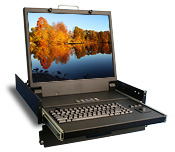 Each LCD, OLED and Plasma display part number, without regard to manufacturer or size, has its own unique “personality” pertaining to optical performance. General Digital Optical Bonding Laboratories understands this challenge and has successfully implemented test and characterization methods. This allows us to better understand the display’s capabilities and potential for improvement. We have on our premises an Optical Characterization Laboratory for obtaining photometrics on any given flat panel display.
Each LCD, OLED and Plasma display part number, without regard to manufacturer or size, has its own unique “personality” pertaining to optical performance. General Digital Optical Bonding Laboratories understands this challenge and has successfully implemented test and characterization methods. This allows us to better understand the display’s capabilities and potential for improvement. We have on our premises an Optical Characterization Laboratory for obtaining photometrics on any given flat panel display.
Luminance
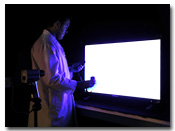 In our Optical Characterization Laboratory, General Digital Optical Bonding Laboratories obtains brightness metrics of your display under dark room conditions and three different simulated daylight conditions. We then do an evaluation of the OEM films in the LCD, OLED or Plasma display and provide analysis on the best configuration based on your expected operating condition. We perform multiple iterations of backlight film modifications and submit the data to you, along with our analysis of what the metrics indicate.
In our Optical Characterization Laboratory, General Digital Optical Bonding Laboratories obtains brightness metrics of your display under dark room conditions and three different simulated daylight conditions. We then do an evaluation of the OEM films in the LCD, OLED or Plasma display and provide analysis on the best configuration based on your expected operating condition. We perform multiple iterations of backlight film modifications and submit the data to you, along with our analysis of what the metrics indicate.
Contrast
In addition to our luminance measuring, General Digital Optical Bonding Laboratories also provides you with empirical contrast ratios based on the multiple lighting conditions utilized in the luminance measuring process. This assists in the decision process of which configuration will best suit your application.
Temperature and Humidity Testing Available on Contract
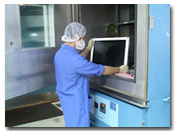 In response to the challenging needs of our diverse customer base, General Digital Optical Bonding Laboratories provides on-site thermal and humidity testing and data logging services. Many customers find themselves faced with meeting strict military, industrial, or harsh environmental requirements. Some of these requirements include:
In response to the challenging needs of our diverse customer base, General Digital Optical Bonding Laboratories provides on-site thermal and humidity testing and data logging services. Many customers find themselves faced with meeting strict military, industrial, or harsh environmental requirements. Some of these requirements include:
- MIL-STD-810 (paragraphs 501.4, 502.4, 507.4)
- ESS (Environmental Stress Screening)
- Solar Loading (for use in direct sunlight)


